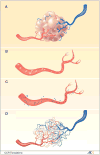Has quantitative multimodal imaging of treatment response arrived?
- PMID: 19861463
- PMCID: PMC2783451
- DOI: 10.1158/1078-0432.CCR-09-2257
Has quantitative multimodal imaging of treatment response arrived?
Abstract
Although there have been dramatic increases in the range and quality of information available from noninvasive imaging methods, their application in clinical trials has been limited. One promising approach is to apply imaging techniques in preclinical studies designed to mimic a corresponding clinical trial in order to inform that trial.
Figures

Comment on
-
Quantifying antivascular effects of monoclonal antibodies to vascular endothelial growth factor: insights from imaging.Clin Cancer Res. 2009 Nov 1;15(21):6674-82. doi: 10.1158/1078-0432.CCR-09-0731. Epub 2009 Oct 27. Clin Cancer Res. 2009. PMID: 19861458 Free PMC article.
References
-
- Eisenhauer EA, Therasse P, Bogaerts J, et al. New response evaluation criteria in solid tumours: revised RECIST guideline (version 1.1) Eur J Cancer. 2009;45:228–47. - PubMed
Publication types
MeSH terms
Grants and funding
LinkOut - more resources
Full Text Sources
Medical

